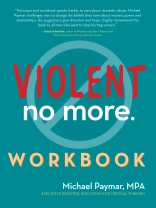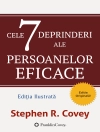This workbook is intended to be used in conjunction with the book
Violent No More: Helping Men End Domestic Abuse, Third Edition.
The exercises in the Violent No More Workbook are specifically designed to help men who batter understand, monitor, and stop their abusive and controlling behavior. Also included are exercises designed for couples who are working through basic relationship issues such as negotiating, communicating, compromising, and disagreeing without becoming abusive or controlling.
Mental health counselors or facilitators in domestic abuse programs make the book Violent No More and the Violent No More Workbook available to men in their domestic abuse groups or the clients they are seeing on an individual basis. Some programs provide the book and workbook to participants as part of their fee; others require participants to purchase the book and workbook, or contribute to the cost. The Violent No More Workbook is an easy to use, step-by-step process that is written directly to men.
Men who batter can change if they have the courage and motivation to change. The exercises in this workbook will help them on their journey.
Содержание
Foreword
Preface
Acknowledgments
Introduction
Why Write a Book for Men Who Batter?
A Note to the Reader
Chapter 1: A Challenge for Men
Andy’s Story
Andy’s Story Five Years Later
The First Step: Owning the Problem
The Next Step: Getting Help
How to Use This Book
Chapter 2: The Roots of Men’s Violence against Women
The Superman Myth
How Our Culture Encourages Violence
The Struggle for Equality
What Men Expect from Relationships
Chapter 3: The Origins of Abuse and Sexual Violence
Cassie’s Story
Bernice’s Story
Women and Violence
The Violence We Learn at Home
The Violence We Learn from Society
Why We Use Violence
Sexual Violence
The Impact of Violence on Sexual Relationships
Chapter 4: It’s More Than Just Physical Violence
Jim’s Story
Using Intimidation to Control
Using Threats
Blocking Her Freedom to Decide
Using the Children to Get to Her
The Pain of Emotional Abuse
Understanding and Stopping Battering
Chapter 5: Getting Past Denial
Sid’s Story
Taking Responsibility
Minimizing Violence
Self-Defense or Retaliation?
Guidelines for Remaining Nonviolent
Letting Go of Blame
Alcohol, Drugs, and Violence
Anger
Chapter 6: Making Changes and Staying on Track
Mark’s Story
Letting Go
Taking Time-Outs
Time-Out Rules
Self-Talk: Learning to Think Positively
Handling Jealousy
The Danger of Obsession
Chapter 7: Staying Together
What Traps a Woman in an Abusive Relationship?
The Switzers’ Story
It May Always Be a Struggle
Understanding and Accepting Women’s Anger
Changing the Mind-Set
Getting Your Needs Met without Being Abusive
Chapter 8: Resolving Conflicts, Strengthening Relationships
Elliot’s Story
New Relationships, Old Problems
Egalitarian Relationships
Sharing the Load
The Issue of Money
Expressing Feelings
Learning to Negotiate and Compromise
Negotiation Guide
Fair Discussion Guide
Developing a Personal Responsibility Program
Chapter 9: Healing
Dave’s Story
Dave’s Story Five Years Later
Support for Changing Men
New Definitions of Masculinity
Health and Balance 1
Dating: How Much of the Past Do We Reveal?
Talking to Your Children about Your Violence
Staying on Course: Your Lifelong Commitment
Chapter 10: Veterans Coming Home
Hector’s Story
Screening for Mental Health Problems
Veteran’s Courts
Changing Military Culture
Chapter 11: Creating Change in Groups
Ron’s Story
Expectations of Counseling
The Theory and Practice of Offender Programs
The Duluth Curriculum: New Approaches
How Well Does Counseling Work?
The Principles of an Offender Program
Intake, Orientation and Screening
Partner Orientation and Safety Procedures
Controversies in the Field
Research: What Do We Know?
Women that Use Violence in Relationships
Chapter 12: Danger and Lethality
Dale’s Story from Prison
Assessment Tools
Chapter 13: Primary Prevention: The New Frontier
Stopping Rape on College Campuses
Reducing Demand for Violent Pornography
Trafficking: Choices for Men
Backlash: The War on Women
Social Change
Об авторе
Michael Paymar, MPA, has worked in the domestic abuse prevention field for over thirty years. He and his colleague the late Ellen Pence authored the groundbreaking curriculum Creating a Process for Change for Men Who Batter, the most widely used treatment model in the world. They worked together at the pioneering Domestic Abuse Intervention Project in Duluth, Minnesota, creating the Duluth Model. He wrote the award-winning documentary With Impunity: Men and Gender Violence. As a member of the Minnesota House of Representatives for almost two decades, Michael Paymar authored legislation to combat domestic and sexual abuse and sex-trafficking. In the third edition of Violent No More and in this accompanying workbook, Michael provides insight into gender violence and offers hope for men who want to change their behavior and live violence-free lives.












